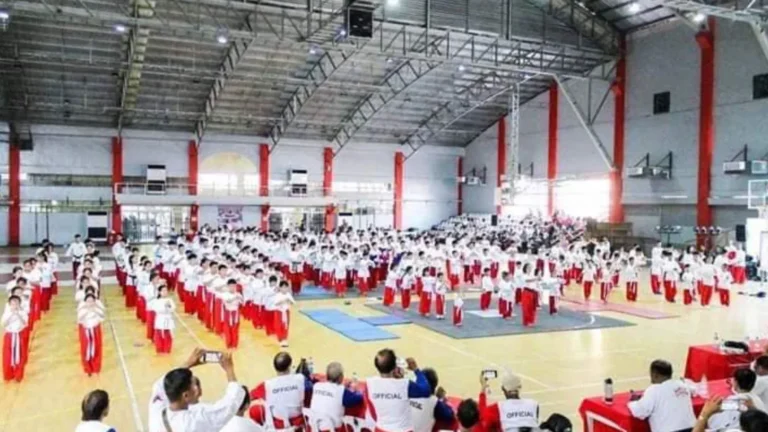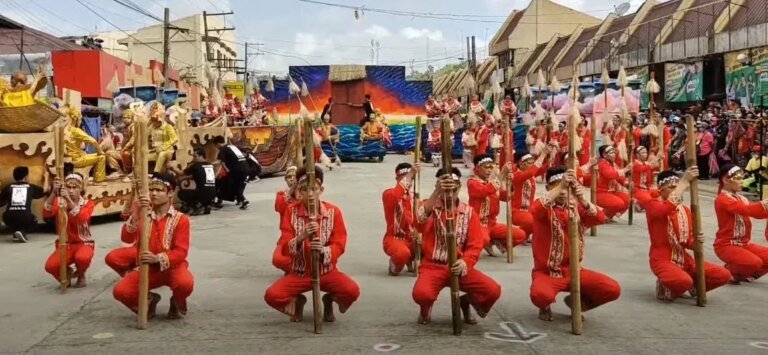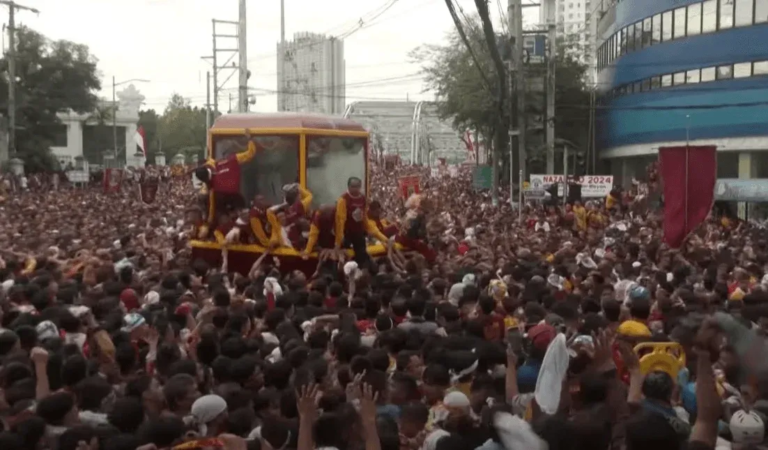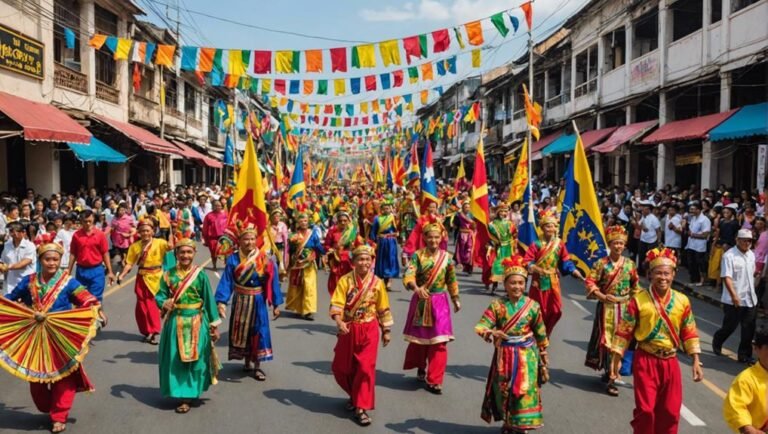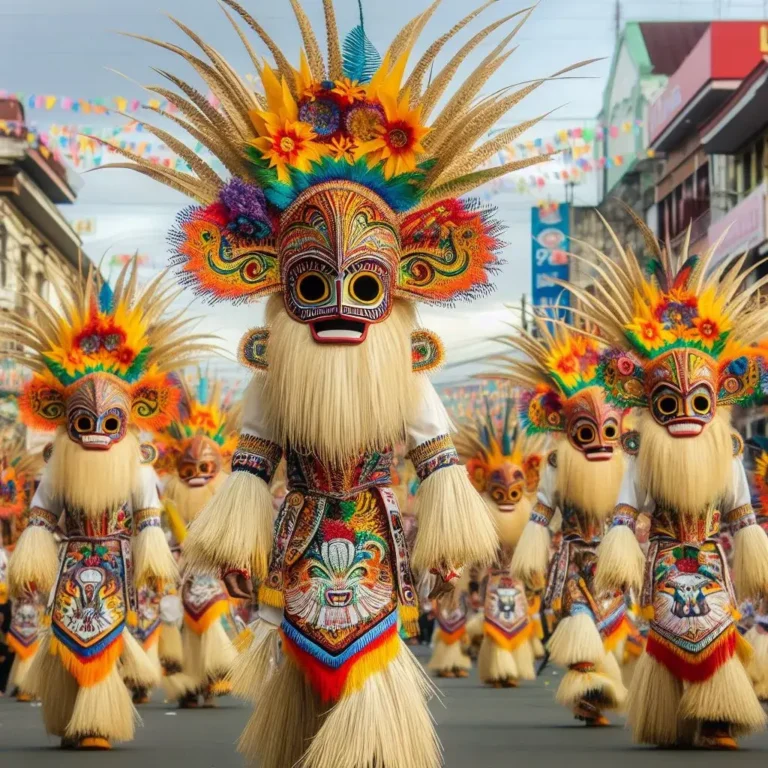Panagdadapun Festival Palawan Philippines

Image Credit: Image by Lilliane YC from Pixabay
Experience the Panagdadapun Festival in Quirino Province, a vibrant celebration of culture and unity. From September 6 to 10, join locals and visitors in Cabarroguis for a diverse showcase of indigenous peoples.
This festival is not just an event, but a living museum highlighting Quirino’s ethnic groups. It promotes public service, environmental advocacy, and indigenous artistry.
Witness traditional games and beauty pageants, and even participate online. Immerse yourself in the heart and soul of Quirino’s communities at this anticipated event.
Key Takeaways
- Quirino Province serves as the vibrant hub and cultural epicenter of the Panagdadapun Festival.
- The festival showcases the blending of old customs with modern festivities, highlighting Quirino’s efforts.
- The Unity Festival symbolizes unity in diversity and cultural exchange, bringing together diverse cultures within the province.
- The festival allows visitors to immerse themselves in the indigenous tribes’ traditions, customs, and vibrant tribal costumes.
Facts About Panagdadapun Festival Philippines
| Facts | Explanation |
|---|---|
| Name of the Festival | Panagdadapun Festival |
| Type of Festival | Cultural and Religious Festival |
| Festival Etymology | “Panagdadapun” means “gathering” in the local language |
| Brief History of the Festival | The Panagdadapun Festival is a celebration of thanksgiving, showcasing the rich cultural heritage of the indigenous people of the Philippines. It is a time for traditional dances, music, and rituals, as well as a display of indigenous crafts and cuisine. |
| Brief History of the City | The festival is celebrated in the city of Tagum, known as the “Palm City of the Philippines.” Tagum has a history rooted in agriculture and has grown into a bustling urban center. |
| Location of the City | Tagum City is located in the province of Davao del Norte, in the southern part of the Philippines. |
| How to Reach the City | Tagum City is accessible by air through the Francisco Bangoy International Airport in Davao City, and by land transportation from major cities in Mindanao. |
| Nearby Cities/Towns | Tagum City is accessible by air through the Francisco Bangoy International Airport in Davao City and by land transportation from major cities in Mindanao. |
| Google Map Link | Tagum City Location |
| Ethnic Information | The festival highlights the ethnic tribes of the region, such as the Mansaka, Mandaya, and Lumad peoples, showcasing their traditional dances, music, and crafts. |
| Festival Main Events | – Traditional Dances and Music Performances – Indigenous Crafts Exhibition – Indigenous Cuisine Showcase – Rituals and Ceremonies |
| Other Tourist Attractions | – New Christ the King Cathedral – Tagum City Hall – Energy Park – Banana Beach Resort |
| Famous Food Dishes | – Durian (exotic fruit) – Sinuglaw (a dish of grilled pork and fish ceviche) – Kinilaw (raw fish marinated in vinegar and spices) |
| Landmarks in the City | – Tagum City Hall – Banawag Monument – Tagum City Freedom Park – Tagum City Trade and Cultural Center |
| Related Festivals | – Araw ng Dabaw (Davao City) – Kadayawan Festival (Davao City) – Musikahan Festival (Tagum City) |
History of Panagdadapun Festival Philippines
The Panagdadapun Festival in the Philippines is a relatively lesser-known celebration compared to the country’s more famous festivals. It is celebrated in the province of Quirino, located in the Cagayan Valley region of Luzon.
The term “Panagdadapun” comes from the local vernacular, meaning a gathering or a commemoration, which reflects the festival’s essence as a celebration of unity, history, and cultural heritage.
Origins and Significance
The Panagdadapun Festival is an annual event that commemorates the founding anniversary of Quirino Province. It marks the province’s establishment as a separate entity from its mother province, Nueva Vizcaya.
The festival is celebrated every September 10, aligning with the date when Quirino was officially recognized as an independent province in 1971, following the enactment of Republic Act No. 6394.
Historical Context
Quirino Province, named after Elpidio Quirino, the sixth President of the Philippines, has a rich history that predates its official establishment. The area was known for its indigenous peoples and their rich cultural traditions, which have been preserved and are celebrated during the Panagdadapun Festival.
The festival not only commemorates the political formation of the province but also celebrates its cultural and historical heritage, showcasing the traditions of the local communities.
Celebrations and Activities
The Panagdadapun Festival features a variety of activities that highlight the cultural, historical, and natural assets of Quirino Province. These include:
- Agro-Trade Fair: An exhibition of local products, crafts, and delicacies, promoting local industries and artisans.
- Cultural Shows: Performances by local and indigenous groups, showcasing traditional dances, music, and rituals that reflect the province’s diverse cultural heritage.
- Sports Competitions: Events that encourage physical fitness and sportsmanship among the youth and other residents.
- Beauty Pageants: Contests that highlight the beauty and intelligence of the local women, promoting empowerment and cultural pride.
- Parades and Street Dancing: Colorful processions that fill the streets with music, dance, and vibrant costumes, bringing the community together in celebration.
Importance
The Panagdadapun Festival plays a crucial role in fostering a sense of identity and pride among the residents of Quirino Province. It serves as a reminder of the province’s journey towards independence and development, celebrating the unity and resilience of its people.
The festival also acts as a platform for promoting tourism, inviting visitors to experience the natural beauty, cultural richness, and warm hospitality of Quirino.
Quirino Province’s Role in Panagdadapun Festival
In your exploration of the Panagdadapun Festival, you’ll find that Quirino Province plays a significant role, serving as the festival’s vibrant hub and cultural epicenter.
It’s here that the spirit of freedom, unity, and bravery is celebrated, echoing the festival’s origins rooted in the historical resistance against invaders.
Quirino’s contributions to this event are multifold. From organizing dynamic displays of local traditions to showcasing indigenous arts, it’s the lifeblood of the festival. You’ll witness the harmonious blending of old customs with modern festivities, which is a testament to Quirino’s efforts.
Unity Festival: A Cultural Mosaic
As you delve deeper into the Panagdadapun Festival, you’ll discover the Unity Festival, an incredible cultural mosaic that further amplifies the essence of this grand event.
This part of the celebration is a vibrant display of unity and freedom, where diverse cultures within the province converge. You’ll be captivated by the colorful cultural costumes, each representing different ethnic groups, their histories, and unique stories. These aren’t just costumes, they’re symbols of identity, worn with pride and respect.
And let’s not forget the festival food, a delightful array of local delicacies that’ll tantalize your taste buds, capturing the province’s culinary heritage.
This cultural mosaic isn’t just about fun and frolic. It’s a testament to unity in diversity, a shared celebration of freedom, and a rich tapestry of cultural exchange.
Panagdadapun’s Indigenous Tribes
While you’re exploring the Panagdadapun Festival, you’ll also get to know the area’s indigenous tribes, each with their unique traditions and customs that add depth to the event’s cultural richness.
Among the vibrant tribal costumes, you’ll witness a visual symphony of colors and patterns, each telling a distinct story of tribal heritage and bravery.
Listen closely, and you’ll hear the echo of tribal languages, an integral part of their unique identity, serving as a living symbol of their resistance and resilience. Here, freedom isn’t just desired; it’s celebrated. So, let your spirit be free, immerse yourself in the tribal culture, and understand the essence of the festival.
This experience will give you a profound insight into their rich history and resilient spirit.
Ethnic Dances and Local Crafts
You’ll be captivated by the ethnic dances and local crafts showcased at the Panagdadapun Festival, each telling a tale of Palawan’s rich cultural heritage.
The festival is a visual feast, with the dance costume’s evolution providing a fascinating insight into the tribe’s history. From simple, raw materials to intricate, vibrant designs, you can see how tradition and modernity intertwine seamlessly.
The local crafts exhibit, on the other hand, showcases the craftsmanship techniques of Palawan’s indigenous people. You’ll find handwoven baskets, intricate beadwork, and masterfully carved wooden sculptures, each piece a testament to their artistry and ingenuity.
These crafts are more than just objects; they’re an expression of the tribe’s spirit of freedom and their enduring connection to their roots.
This festival, indeed, is a celebration of cultural continuity and artistic freedom.
History Of Quirino Province Philippines
Quirino Province has a relatively young history compared to other provinces. However, its story is intertwined with indigenous settlements, colonial influences, and the eventual journey toward provincialhood.
Early Inhabitants
Long before formal governance, Quirino’s forested lands were home to indigenous groups like the Negritos and Ilongots. The Negritos, known as the “Pugots,” roamed the hinterlands, while the Ilongots established settlements closer to rivers and practiced various agricultural activities.
Colonial Encounters
Spanish colonization in the 16th century brought significant changes. While some indigenous communities resisted, others gradually interacted with the colonizers, adopting elements of Christianity and integrating into colonial structures. Townships like Diffun and Cabarroguis emerged during this period.
Post-Colonial Developments
Following Philippine independence in 1898, Quirino remained part of Nueva Vizcaya province. Its fertile lands attracted migrant settlers, particularly Ilocanos, who introduced new agricultural practices and contributed to population growth.
The Road to Provincialhood
The 20th century saw growing calls for autonomy. In 1966, Republic Act 4734 paved the way for the creation of a sub-province named Quirino, in honor of President Elpidio Quirino. Five years later, R.A. 5554 established the municipality of Cabarroguis as its capital.
Finally, on September 10, 1971, R.A. 6394 officially separated Quirino from Nueva Vizcaya, making it a full-fledged province. The first elected officials took office the following year, marking a significant milestone in the province’s history.
Since then, Quirino has covered a journey of development, focusing on agriculture, forestry, and ecotourism. Despite challenges like insurgency and natural disasters, the province continues to progress, cherishing its unique cultural heritage and striving for a brighter future.
Here are some additional points to consider:
- Indigenous influence: Although not as widely known, understanding the history and contributions of indigenous groups like the Ilongots enriches the narrative of Quirino’s past.
- Economic development: Exploring the evolution of Quirino’s agricultural sector and the rise of other industries provides valuable insights into the province’s economic trajectory.
- Socio-political landscape: Examining the political scene, including prominent local figures and their roles, deepens the understanding of Quirino’s governance and societal dynamics.
Famous Historical Personalities From Quirino Province Philippines
While Quirino Province, being relatively young compared to other Philippine provinces, may not have as many widely known historical figures, there are certainly individuals who have made significant contributions to the province’s development and hold importance in its local history. Here are a few examples:
Politicians:
- Elpidio Quirino: The 6th president of the Philippines (1948-1953), for whom the province is named. He played a key role in securing Philippine independence from the United States and focused on post-war reconstruction efforts.
[Image of Elpidio Quirino, Philippines] - Leonardo B. Perez: A former congressman, senator, and chairman of the Commission on Elections. He played a crucial role in advocating for the creation of Quirino province as a separate entity from Nueva Vizcaya.
- Benjamin B. Perez: A former congressman and assemblyman. He worked alongside his brother Leonardo in pushing for the establishment of Quirino province.
Religious Figures:
- Fr. Gregorio Aglipay: A priest who founded the Philippine Independent Church, also known as the Aglipayan Church. The town of Aglipay in Quirino province is named after him.
[Image of Fr. Gregorio Aglipay, Philippines] - Bishop Juan S. Farillon: The first Filipino bishop of the Episcopal Church in the Philippines. He established the Saint Michael’s Theological College in Cabarroguis, Quirino, which has become a significant center for theological education in the region.
Indigenous Leaders:
- Datu Macuroy: A leader of the Ilongot people who resisted Spanish colonization in the 19th century. He is considered a hero by the Ilongot community in Quirino province.
- Apo Bakung: A spiritual leader and cultural icon of the Ilongot people. He is known for his knowledge of traditional rituals and customs and his efforts to preserve Ilongot culture.
It’s important to remember that history is often shaped by many individuals, not just those in positions of power or with widespread recognition. Many ordinary people in Quirino province have contributed to its rich history and cultural heritage through their everyday lives and traditions.
Famous Local Cuisine In Quirino Province Philippines
Quirino Province is not only known for its natural beauty and outdoor adventures but also for its unique and flavorful local cuisine. The culinary offerings in Quirino reflect a blend of indigenous practices, natural bounty, and influences from neighboring regions.
Here are some famous local dishes and culinary specialties from Quirino Province:
1. Pinuneg
- Description: A type of blood sausage that is popular among the indigenous communities in Quirino and the Cordillera region. Made from minced pork, pork blood, and spices, it is traditionally grilled or fried.
- Taste Profile: Rich and savory with a hint of spiciness, pinuneg is often enjoyed as part of a hearty meal or as a snack.
2. Inatata
- Description: A traditional rice cake from Quirino, inatata is made from glutinous rice, coconut milk, and sugar, wrapped in banana leaves, and then steamed.
- Taste Profile: Sweet and sticky, with a creamy texture from the coconut milk, it’s a favorite dessert or snack, especially during festivities and special occasions.
3. Binallay
- Description: Similar to inatata, binallay is another type of rice cake native to Quirino and the Cagayan Valley region. It’s also made from glutinous rice and wrapped in banana leaves but is distinct in its preparation and presentation.
- Taste Profile: Soft and slightly sweet, often served with a topping of latik (cooked coconut milk curd) for added flavor.
4. Sinursur
- Description: A unique dish made from the young leaves of the rattan plant, cooked with coconut milk and spices. It’s a testament to the indigenous people’s knowledge of utilizing available natural resources.
- Taste Profile: Earthy and creamy, with a slight bitterness balanced by the richness of coconut milk.
5. Ludong
- Description: Known as the “President’s Fish,” ludong is a rare and highly prized fish found in the Cagayan River and its tributaries, including areas in Quirino. It’s known for its delicate taste and is often simply grilled or cooked in a broth.
- Taste Profile: Delicate, mild, and slightly sweet, with a texture that’s tender and flaky.
6. Bamboo-cooked Dishes
- Description: Utilizing bamboo as a cooking vessel is a traditional practice in Quirino. Various dishes, including rice, meats, and vegetables, are cooked inside bamboo tubes, infusing them with a distinct aroma and flavor.
- Taste Profile: The bamboo imparts a subtle woody and smoky flavor to the food, enhancing its natural tastes.
7. Wild Honey
- Description: Quirino’s forests are home to bees that produce wild honey, which is harvested by the locals. This natural sweetener is used in various dishes, desserts, and as a condiment.
- Taste Profile: Rich, aromatic, and varies in sweetness and intensity depending on the flowers from which the bees collect nectar.
Historic Places In Quirino Province Philippines
Quirino Province, nestled in the southeastern part of the Cagayan Valley in the Philippines, may not be as widely known for historical landmarks as other parts of the country, but it boasts a rich cultural heritage and natural beauty.
While it’s more celebrated for its ecological attractions, there are several sites within and around the province that hold historical significance and offer insights into the region’s past. Here are some historic places and cultural sites in and near Quirino Province:
1. Aglipay Caves
- Location: Aglipay, Quirino
- Significance: Named after the Philippine Independent Church’s founder, Gregorio Aglipay, these caves are not only natural wonders but also hold historical importance. The complex network of caves served as a natural shelter and possibly as a hideout during various periods of conflict, including World War II.
2. St. Mark’s Parish Church
- Location: Cabarroguis, Quirino
- Significance: While relatively modern in construction, this church is significant for its role in the spiritual and cultural life of the province’s capital. It represents the Catholic faith’s enduring presence in the region, a testament to the Spanish colonial era’s lasting influence on the Philippines.
3. Governor’s Rapids
- Location: Maddela, Quirino
- Significance: While known for its breathtaking beauty and as a site for adventure tourism, Governor’s Rapids also has historical value. The area is named after a former governor and is noted for its role in local history as a transport route and for its indigenous people’s cultural practices.
4. Nagtipunan Domain
- Location: Nagtipunan, Quirino
- Significance: This area is rich in cultural history, being a significant site for the indigenous Bugkalot (Ilongot) tribe. The region offers insights into the traditional lifestyles, practices, and the enduring legacy of the indigenous peoples of Quirino and the Cagayan Valley.
Nearby Historical Sites
While Quirino itself is more of an ecological and adventure destination, neighboring provinces in the Cagayan Valley and the Cordilleras have notable historical sites that can offer a broader understanding of the region’s history:
5. Bessang Pass Natural Monument
- Location: Cervantes, Ilocos Sur (near the boundary with Quirino)
- Significance: This historical site commemorates the victory of Filipino soldiers over Japanese forces during World War II. Bessang Pass was a strategic point, and its capture marked a significant turning point in the liberation of Northern Luzon.
6. Yamashita Treasure Sites
- Location: Various locations in Northern Luzon
- Significance: While more myth than documented history, several sites in Northern Luzon, including areas close to Quirino, have been rumored to be hiding places for the infamous Yamashita treasure. These stories contribute to the mystique of the region and its allure for treasure hunters and history enthusiasts.
7. Museums and Cultural Centers in Nearby Provinces
- Location: Isabela, Nueva Vizcaya, and Cagayan
- Significance: Neighboring provinces house museums and cultural centers that display artifacts, historical documents, and exhibits on the indigenous peoples and the colonial history of the Cagayan Valley region, offering a deeper dive into its past.
How To Reach Quirino Province Philippines
Reaching Quirino Province in the Philippines involves a combination of land travel and, for those coming from far-off places, potentially air travel to get closer to the region. Quirino is nestled in the southeastern part of the Cagayan Valley region, bordered by Nueva Vizcaya, Isabela, and Aurora.
Its relative remoteness adds to the charm and adventure of visiting this province known for its natural attractions like caves, waterfalls, and rivers. Here’s how you can get to Quirino Province:
From Manila
By Land
- Direct Bus: There are no direct flights to Quirino Province, so the most common way to reach it is by bus from Manila. Direct bus services are available from Metro Manila to Quirino. Companies like GV Florida Transport and Dalin Liner offer trips to Quirino, specifically to towns like Maddela and Cabarroguis. The journey can take approximately 8 to 10 hours, depending on traffic and weather conditions.
- Via Nueva Vizcaya: Alternatively, you can take a bus bound for Santiago, Isabela, or Tuguegarao, Cagayan, and alight in Nueva Vizcaya. From there, take a van or another bus that goes directly to various municipalities in Quirino.
By Air (then Land)
- To Cauayan, Isabela or Tuguegarao, Cagayan: For a quicker route, you can fly from Manila to Cauayan Airport in Isabela or Tuguegarao Airport in Cagayan. From either airport, you can take a bus or a van going to Quirino. The air travel cuts down the travel time significantly, followed by a 2 to 3-hour land journey to reach the province.
Tips for Travelers
- Travel Time: Always allow for extra travel time for any unforeseen delays, especially if traveling during the rainy season or holidays.
- Booking Tickets: It’s advisable to book your bus or van tickets in advance, particularly during peak travel seasons like summer and Christmas, to ensure your seat.
- Accommodations: Consider booking your accommodations in advance. While Quirino is not as crowded as other tourist destinations, it’s always best to have your lodging sorted before your arrival.
- Local Transport: Once in Quirino, local transportation options include tricycles, jeepneys, and hired vans for getting around and exploring the attractions.
- Travel Essentials: Bring appropriate clothing for outdoor activities, as Quirino offers numerous adventure and eco-tourism experiences. Also, pack any necessary medications, insect repellent, and other travel essentials, as some areas may have limited access to stores.
Location Of Quirino Province In The Philippines
Surprising Facts About The Panagdadapun Festival Palawan Philippines
Here are 10 interesting and perhaps surprising facts about the Panagdadapun Festival of Palawan:
- 🌴 The Panagdadapun Festival is exclusive to the province of Palawan, celebrating its rich cultural diversity and history.
- 📅 It is celebrated annually on March 4th, marking the foundation day of Palawan as a province.
- 🤝 “Panagdadapun” is a Cuyonon word meaning “to commemorate,” reflecting the festival’s emphasis on remembering and celebrating the province’s history and achievements.
- 🎭 The festival includes a variety of cultural performances, showcasing traditional dances, music, and costumes from different ethnic groups within Palawan.
- 🍲 Food plays a significant role in the celebrations, with local culinary specialties and delicacies being prepared and shared among participants and visitors.
- 🏝️ Palawan is known as the “Last Frontier” of the Philippines, and the festival highlights the environmental conservation efforts and natural beauty of the province.
- 🛶 Traditional boat races, known locally as “bangka” races, are among the aquatic sports featured during the festival, celebrating Palawan’s strong connection to the sea.
- 🎨 Art exhibitions and workshops are organized, featuring local artists and craftsmen, to promote Palawan’s arts and crafts.
- 👑 The festival includes a pageant known as “Mutya ng Palawan,” which seeks to find a young woman who exemplifies the beauty, intelligence, and cultural heritage of Palawan.
- 🌏 The Panagdadapun Festival serves as a platform for promoting eco-tourism, highlighting Palawan’s unique ecosystems, such as the Underground River and the Tubbataha Reefs Natural Park, to visitors from around the world.
Summary Of Panagdadapun Festival
| Fact | Details |
|---|---|
| Name | Panagdadapun Festival |
| Celebration Focus | Culture, Founding, Indigenous People |
| Country | Philippines |
| Date | September 6 to 10 |
| Duration | Five days |
| Location | Cabarroguis, Quirino |
| Organizer | Provincial Government of Quirino |
| Simultaneous Event | Araw ng Quirino Foundation |
| Website | Medical and dental services, job fairs, cultural exhibits, ethnic arts and crafts sales, pet shows, native games competitions, talent contests, environmental activities (tree planting, waste management), sporting events, grand parade, street dancing. |
| Main Activities | Medical and dental services, job fairs, cultural exhibits, ethnic arts and crafts sales, pet shows, native games competitions, talent contests, environmental activities (tree planting, waste management), sporting events, grand parade, and street dancing. |
| Special Events | Search for Binibining Quirino (beauty pageant), Quirino Motorismo (motor event) |
| Transportation to Quirino | Bus from Metro Manila or Baguio; Flights to Cauayan Airport of Isabela or Tuguegarao Airport followed by a land trip. |
| Historical Significance | The word ‘Panagdadapun’ is Ilocano for gathering. The festival celebrates the founding of Quirino Province, named after President Elpidio Quirino. Originally part of Nueva Vizcaya, it became an independent province on September 10, 1971. |
| Indigenous Groups | Negritos, Bugkalots, Dumagats, Gaddang, Ifugaos, Isinays |
| Legislative Acts | Republic Act No. 4734 (June 18, 1966), Republic Act No. 5554 (June 21, 1969), Republic Act No. 6394 (September 10, 1971), Batasang Pambansa Blg. 345 (February 25, 1983) |
Related References
| Reference | Link |
|---|---|
| Bicarme, Thelma. I Love Quirino Color Run slated on Sept 10. Philippine Information Agency. | Link |
| Visaya, Villamor Jr. Unique culture unfurled in Quirino’s Panagdadapun Festival. | Link |
| Festivals. Provincial Government of Quirino. | Link |
| Brief History of Quirino Province. Provincial Government of Quirino. | Link |
| Republic Act No. 6394. Senate of the Philippines. | Link |
| Republic Act No. 4734, June 18, 1966. Supreme Court of the Philippines E-Library. | Link |
| Visaya, Villamor Jr. Indigenous folk’s cultural heritage gets boost in Panagdadapun Festival. Philippine Daily Inquirer. | Link |
| Panagdadapun Festival highlights Quirino’s cultural heritage. Manila Standard. | Link |
| About Quirino Province. Region 2 Fun – Department of Tourism. | Link |
| Batasang Pambansa Blg. 345, February 25, 1983. Senate of the Philippines. | Link |
Frequently Asked Questions
What Is the Best Time of Year to Visit the Panagdadapun Festival in Palawan, Philippines?
You’d want to visit during September. That’s when the festival preparation peaks, enhancing the cultural significance of your experience. It’s a liberating time to immerse yourself in the local traditions and festivities.
What Are Some Traditional Foods Served During the Panagdadapun Festival?
You’ll love exploring local ingredients in dishes like the tangy Kinilaw and hearty Adobo. Understanding the culinary history of Palawan, you’ll appreciate how these traditional foods bring the community together during festivities.
How Is the Panagdadapun Festival in Palawan Different From Other Filipino Festivals?
You’ll find that this festival stands out due to its cultural significance and unique origin. Unlike many others, it emphasizes unity and reconciliation, making it a deeply meaningful event in the Filipino cultural landscape.
How Can Foreign Tourists Participate in the Panagdadapun Festival?
To join in local festivities, you’ll need to understand the cultural significance and follow festival etiquette. Engage with locals, participate in traditional activities, respect customs, and immerse yourself in the vibrant cultural experience.
What Accommodations and Amenities Are Available for Visitors During the Panagdadapun Festival?
You’ll find a range of accommodations, from luxury resorts to budget hostels. Amenities often include cultural performances and festival souvenirs. It’s a rich experience, blending comfort with cultural immersion. Enjoy your stay!
Conclusion
The Panagdadapun Festival in Palawan, Philippines is a vibrant celebration that reflects the cultural richness of the country.
Taking place every September 6 to 10 in Quirino Province, the festival showcases the unique culture and history of the region through a grand parade that symbolizes the convergence of various tribes.
It not only commemorates Quirino’s history but also highlights the passionate spirit of Filipinos for singing and dancing. The festival’s significance extends beyond its geographical confines, resonating with those who appreciate the diverse cultural heritage of the Philippines.
It is a fusion of history, tradition, and contemporary expressions, making it a cherished annual tradition in Palawan.

